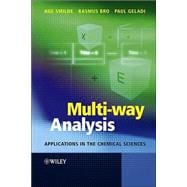
What is included with this book?
Age K. Smilde received his MSc in Econometrics at the University of Groningen in 1986. He moved to the Department of Pharmacy in the same city where he did his PhD in Analytical Chemistry. His PhD was on "Multivariate Calibration of Reversed Phase Chromatographic Systems", and he received his degree in 1990. In the year 1992, he visited the Center for Process Analytical Chemistry (Seattle, USA), where he worked together with Prof. Bruce Kowalski. He is the Eastern Analytical Symposium 2006 Award Recipient for Achievements in Chemo metrics. In 1996 he was chairman of the Gordon Research Conference on Statistics in Chemistry and Chemical Engineering in Oxford (UK). Together with Rasmus Bro and Paul Geladi he wrote the book Multiway Analysis: Applications in the Chemical Sciences.
Rasmus Bro (born 1965) studied mathematics and analytical chemistry at the Technical University of Denmark and received his M.Sc. in 1994. In 1998 he obtained his Ph.D. (Cum Laude) in multiway analysis from the University of Amsterdam, The Netherlands. In 2000 he received the third Elsevier Chemo metrics Award for noteworthy accomplishments in the field of chemo metrics by younger scientists, and in 2004 he received the Eastern Analytical Symposium Award for Achievements in Chemo metrics. He has authored more than 100 peer-reviewed scientific papers, 2 books on chemo metrics, and more than 20 proceedings, book contributions, reviews, and patents.
Paul Geladi currently works at the Department of Food Science, Stellenbosch University. Paul does research in Analytical Chemistry, Chemo-informatics and Electrochemistry. Their most recent publication is 'Covalently electro grafted carb ox phenyl layers onto gold surface serving as a platform for the construction of an immune sensor for detection of methotrexate.
|
|||
|
|||
|
|||
|
|||
|
|||
|
|||
|
|||
|
|||
|
|||
|
|||
|
|||
|
|||
|
|||
|
|||
|
|||
|
|||
|
|||
|
|||
|
|||
|
|||
|
|||
|
|||
|
|||
|
|||
|
|||
|
|||
|
|||
|
|||
|
|||
|
|||
|
|||
|
|||
|
|||
|
|||
|
|||
|
|||
|
|||
|
|||
|
|||
|
|||
|
|||
|
|||
|
|||
|
|||
|
|||
|
|||
|
|||
|
|||
|
|||
|
|||
|
|||
|
|||
|
|||
|
|||
|
|||
|
|||
|
|||
|
|||
|
|||
|
|||
|
|||
|
|||
|
|||
|
|||
|
|||
|
|||
|
|||
|
|||
|
|||
|
|||
|
|||
|
|||
|
|||
|
|||
|
|||
|
|||
|
|||
|
|||
|
|||
|
|||
|
|||
|
|||
|
|||
|
|||
|
|||
|
|||
|
|||
|
|||
|
|||
|
|||
|
|||
|
|||
|
|||
|
|||
|
|||
|
|||
|
|||
|
|||
|
|||
|
|||
|
|||
|
|||
|
|||
|
The New copy of this book will include any supplemental materials advertised. Please check the title of the book to determine if it should include any access cards, study guides, lab manuals, CDs, etc.
The Used, Rental and eBook copies of this book are not guaranteed to include any supplemental materials. Typically, only the book itself is included. This is true even if the title states it includes any access cards, study guides, lab manuals, CDs, etc.